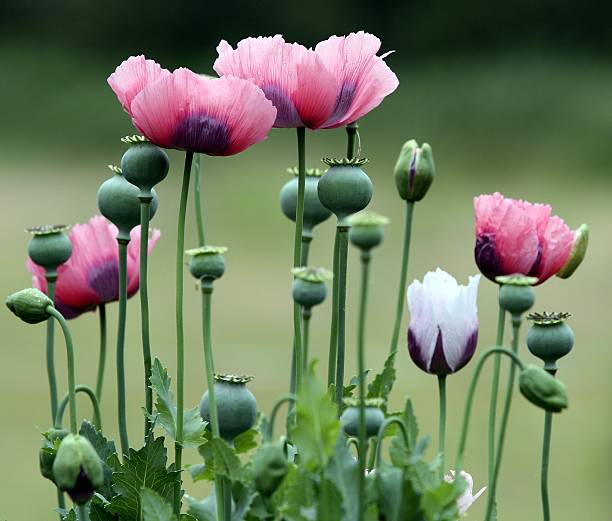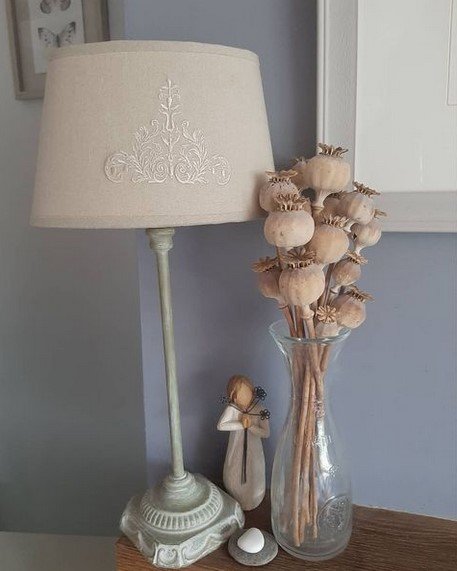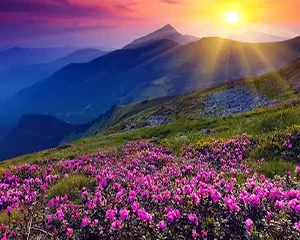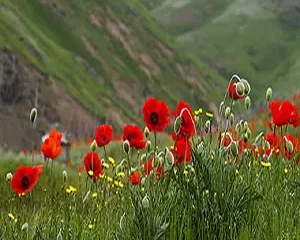Opium poppy specifications
- Scientific name : Papaver somniferum L
- Order : Ranunculales
- Family : Papaveraceae
- Genus : Papaver
- Species : P. somniferum
- French name : P. des jardins, Pavot d’opium, P. pourpre, Pavot somni fè re
- English name : Opium poppy
- German name : Opium mohn, Garten mohn, Mohn
- Italian name : Papavero da oppio, Grand papavero, Papavero somnifer
Opium poppy , any of several flowering plants of the poppy family (Papaveraceae), especially species of the genus Papaver. Most poppies are found in the Northern Hemisphere, and several species of poppies are cultivated as garden ornamentals.
This herbaceous plant reaches a height of 2 meters. Dusty green leaves, large, beautiful flowers in white to pink, large, capsule-like fruits with a distinct crown at the top are the hallmarks of the plant. Opium poppy is an annual herbaceous plant with a stem height of one to one and a half meters ( its stem is called a band and its fruit is called a mace ) and it blooms from July to August.
read more : Everything about scabiosa flower : How to Plant & care for them

Opium poppy plant
Physical description
Poppies have lobed or dissected leaves and milky sap. The buds are often nodding and are borne on solitary stalks. The flowers have four to six petals with numerous stamens surrounding the ovary. The two sepals usually drop off as the petals unfold. The ovary develops into a spherical capsule topped by a disk formed by the stigmas. The many small seeds escape from pores beneath the disk when the capsule is shaken by the wind.
The place of growth and distribution of the opium poppy plant
Opium poppy is native to Asia Minor and is cultivated in Afghanistan, Turkey, India and China.
read more : Everything about okra plant : How to Plant & care for them
8 Types of Poppies
-
Oriental Poppy ( Papaver orientale )
One of the most familiar of all poppies is the Oriental poppy. This perennial garden plant is a common feature of northern gardens, with its feathery foliage and orange, red, or salmon flowers that bloom in June and July. Some popular cultivars include ‘Allegro’ (a dwarf form that grows to 18 inches), ‘Beauty of Livermere’ (blood-red flowers, growing 2–3 feet), ‘Fatima’ (white flowers edged with pink), ‘Patty’s Plum’ (plum-pink flowers, growing to 30 inches), and ‘Princess Victoria Louise’ (pink flowers, growing to 36 inches).
While people typically grow Oriental poppies for their magnificent blooms, their feathery foliage is also attractive. The foliage disappears in summer as the plant goes dormant, but a new set of basal leaves emerges in the fall. These leaves will overwinter, affording winter interest in areas that receive only light snowfall.
- Native Area : Southern Eurasia
- USDA Hardiness Zones : 2 to 7 (depends on variety)
- Height : 20–36 inches
- Sun Exposure : Full
-
Flanders Poppy, Shirley Poppy ( Papaver rhoeas )
Known as the common poppy or Flanders poppy, this species grew wild on World War I battlefields, becoming a symbol of the war thanks to its mention in the famous poem “In Flanders Fields.” Citizens of the United Kingdom don this bright orange-red bloom to honor Remembrance Day each November 11. One of its equally well-known cultivars, the Shirley poppy, is a more popular landscape plant, available in orange, pink, violet, white, and yellow.
Although the Flanders poppy and its cultivars are annuals, they self-seed so freely that they naturalize in a manner that makes them perform as perennials. This can be a good choice for gardeners in the South who may have trouble with the cold-loving perennial species. In warm climates, the seeds can be sown in fall or winter.
- Native Area : Northern Africa, Europe, Asia
- USDA Hardiness Zones : 3–10 (grown as an annual)
- Height : 9–18 inches
- Sun Exposure : Full
read more : Everything about irises flower : How to Plant & care for them
-
Opium Poppy ( Papaver somniferum )
Though found in the same genus as many popular garden poppies, you might want to steer clear of this one: the opium poppy, from which heroin and other opiate drugs are derived.2 This type of poppy has striking pink, red, purple, or white flowers; has distinctive gray-green foliage; and is taller than most poppy flowers.
Although the opium poppy is an exquisitely attractive plant, growing it is technically illegal throughout the United States.3 This ban also extends to Papaver paeoniflorum, the double-flowered version of the opium poppy. Most major seed retailers offer poppy seeds for sale, and few make any mention of legalities. But, before growing this plant, check with local and state authorities.
- Native Area : Turkey
- USDA Hardiness Zones : 8-10 (grown as an annual)
- Height : 24-36 inches
- Sun Exposure : Full
-
Iceland Poppy ( Papaver nudicaule )
Not all poppies are as easy to grow as the Oriental poppy. A case in point is the Iceland poppy, also known as the Arctic poppy. This is a short-lived perennial, but it performs as an annual only in northern climates. Elsewhere, it’s usually grown as an annual, but it might not grow at all in any region with warm, humid summers. Iceland poppy cultivars are available with bright yellow, white, salmon, rose, and pink flowers.
- Native Area : Arctic, subarctic
- USDA Hardiness Zones : 2–7
- Height : 12–24 inches
- Sun Exposure : Full
-
Himalayan Poppy ( Meconopsis grandis )
Himalayan poppies are technically poppies because their genus is within the Papaveraceae family, but they’re not members of the Papaver genus that comprises most garden poppies. Although the papery blooms have that familiar poppy flower look, they’re an unusual sky blue hue and are quite large — up to 5 inches across.
Make no mistake about it: These are difficult plants to grow from start to finish. The seeds can be difficult to germinate, and the plants require constant moisture (but detest having wet feet) as well as moderate temperatures in both summer and winter (not too hot, not too cold).
Unless you’re able to mimic the conditions of their native Himalayan environment—woody terrain shrouded in cool mist—your chances of success are slim. If you succeed, though, you have earned notable bragging rights.
- Native Area : China
- USDA Hardiness Zones : 3-7
- Height : 3–4 feet
- Sun Exposure : Partial shade
read more : Everything about nigella flower : How to Plant & care for them
-
Plume Poppy ( Macleaya cordata )
The plume poppy is another uncharacteristic poppy flower. Its flowers aren’t the common cup shape but instead form in long panicles (plumes) of white blooms, alongside large scalloped leaves. And, rather than being beautiful and difficult to grow like the Himalayan poppy, it’s not very attractive and quite easy to grow—so easy, in fact, that it crosses over into the invasive category.
This perennial spreads aggressively through rhizomes and self-seeding (if not deadheaded). So, for many, the plume poppy turns out to be one of those beautiful barbarians—a lovely but dangerous plant that ends up being an unwelcome plant in your garden.
- Native Area : China, Japan
- USDA Hardiness Zones : 6–8
- Height : 4–9 feet
- Sun Exposure : Full, Partial
-
Greater Celandine ( Chelidonium majus )
A common roadside poppy, the greater celandine is rarely planted deliberately. This somewhat compact biennial blooms with yellow flowers from May to August, and it self-seeds so aggressively that it can be hard to eradicate, even in a closely tended garden. Across much of the Midwest and the Northeast, it’s dangerously invasive and outcompetes native species as well as being toxic.4
But don’t confuse this species with the lesser celandine (Ranunculus ficaria), which is a member of the buttercup clan, not the poppy family. It looks somewhat like a marsh marigold and generally should be avoided, too, although some cultivars are bred to behave better.
- Native Area : Europe, western Asia
- USDA Hardiness Zones : 4–8
- Height : 12–24 inches
- Sun Exposure : Partial, Full
read more : Everything about red poppy flower : How to Plant & care for them
-
Bloodroot ( Sanguinaria canadensis )
Wildflower watchers are sometimes surprised to learn that bloodroot is a member of the poppy family. This is a low-growing, stemless plant whose leaves and flower stalks emerge directly from the ground. It blooms with white flowers, sometimes tinged with pink, in early spring. Unlike most poppies, which love the sun, this species prefers shady conditions, making it a great choice for gardeners seeking a native species for a shady location. The common name derives from the reddish-orange color of its sap when the roots are cut.
- Native Area : Eastern North America
- USDA Hardiness Zones : 3–8
- Height : 12-14 inches
- Sun Exposure : Partial to full shade
How to Plant Poppies
Growing poppy flowers can be as simple as planting seeds or dividing roots of existing plants. Plant poppies from seed into poor to average soil in a sunny location for a good start to growing poppy flowers in your garden. Poppies grow from a taproot.
When this taproot is disturbed in transplanting, a lost season of bloom may occur when planting poppies. Divide poppies in autumn to allow time for the taproot to restore itself. Planting poppies in either way can provide attractive foliage and large or diminutive flowers in your garden, flower bed or meadow.
read more : Everything about water lily ( lotus ) flower : How to Plant & care for them
How to Grow Poppies
Poppy plant care involves the deadheading of spent flowers, resulting in more prolific blooms of the poppy plant. Poppy flowers need limited watering once they have settled into their location. Too much water can result in tall, leggy, unattractive growth of the growing poppy flower. Choosing the variety of poppy best suited for your garden is an intriguing garden chore.
The Armenian poppy is among the smaller and more delicate offerings. Oriental poppies offer the largest and showiest blooms but may die back during summer heat. California poppies self seed abundantly and should be planted where more poppies are desirable. Learning how to plant poppies correctly provides you with a striking choice for many sunny locations where soil has not been enriched or amended.
Iran dried opium poppy
Due to its unique beauty, dried opium poppy pods have many usages in interior decoration design as well as in traditional medicine and pharmacy. Dried opium poppy pods is one of Iran’s export goods and has provided a great opportunity for Iranian traders to bring a lot of currency to the country by exporting dried opium poppy . Both types of opium poppy flower products can be exported either as medicinal plants or as dried flowers because each has its own customer.
The export of dried opium poppy flowers has provided a great opportunity for wholesalers and exporters of dried opium poppy and other medicinal plants to make significant profits.
read more : Drying natural flowers | Introducing 8 wonderful ways to dry flowers

Dried opium poppy
Used opium poppy parts
- Seeds
- Petals
- Fruits and … are used medicinally.
Planting and harvesting opium poppies
To propagate opium poppy seeds, it is sown in March or early April, depending on the weather and climate of the place. Harvesting is done in three stages. First, after the plant and the capsules arrive, they first razor the capsules with razors, that is, they scratch them.
The depth of the scratches or grooves is about one millimeter and thus leachate or latex comes out of the surface of the capsules. The second stage is the extraction of the juice, which is hardened and rubbed on the surface of the capsule, and at the end of the third stage, the juice is dried.
One of the most valuable medicinal plants is opium poppy, which can be grown in Iran. This plant species has been the basis for the production of more than 70 types of drugs in the world, which are used in combination with other medicinal compounds.
Notice : This article translated by google form Persian language. If you have any question or need more information please contact us or add a comment at the bottom of this page.


0 Comments